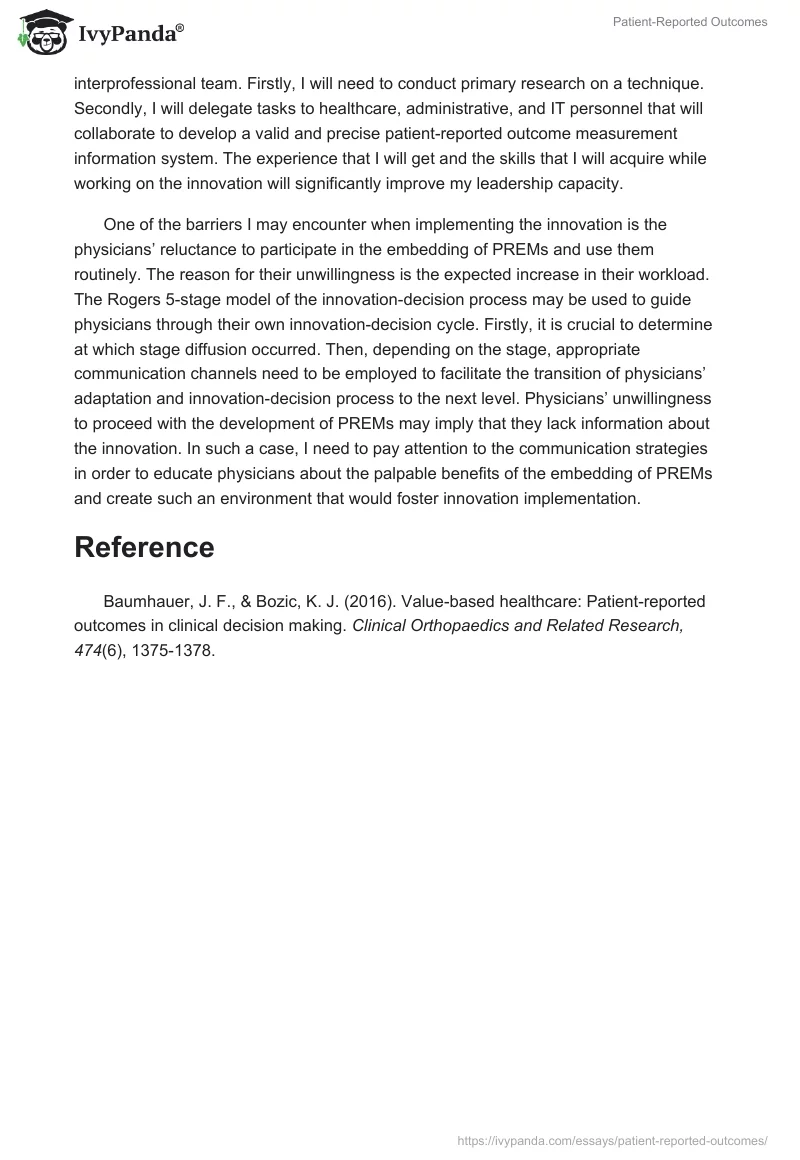Value-based healthcare is becoming a leading approach to the establishment of a more patient-centered and productive healthcare system. The philosophy of such a model provides for the definition of values around the customer and the measurement of outcomes from their perspective. This would allow for setting a logical connection between value and outcome, as opposed to value and input. The proposed future development that affects value-based healthcare is the embedding of patient-reported experience measures (PREMs) into routine practice.
In a well-functioning system of healthcare, the value created for patients should predetermine profit and rewards obtained by healthcare professionals. As validated tools used to collect the patient’s experience with a healthcare system, PREMs will assess the extent to which the medical services added to patient satisfaction (Baumhauer & Bozic, 2016). Data derived from these instruments will be further used to inform healthcare decision-making and service development. PREMs may be regarded as a helpful tool in measuring outcomes achieved from a patient’s perspective. Not only will the introduction of PREMs facilitate medical understanding of the effect of treatment on a patient’s well-being, but it will also narrow a gap between clinical realities in which a patient and a physician live.
Thus, the suggested innovation helps solve the problem of outcomes being measured based on the volume of services provided. The utilization of PREMs enables healthcare providers to consider a patient’s feedback, quantify it, and tailor treatment plan to meet their needs. The regular use of data collected through PREMs is expected to enhance the physician-patient relationship and decision-making, as well as improve customer satisfaction. The proposed development will impact value-based healthcare by shifting a focus from volume to value of care delivered by healthcare professionals. Implementation of PREMs considers customers as the center of a healthcare system, and patient feedback on healthcare outcomes may improve treatment adherence and facilitate recovery. As a result, customers will pay not for the services they receive but for the value obtained from such services.
The work on innovation will upgrade my leadership capacity as I will need to utilize all my previous knowledge, skills, and experience to organize and lead the interprofessional team. Firstly, I will need to conduct primary research on a technique. Secondly, I will delegate tasks to healthcare, administrative, and IT personnel that will collaborate to develop a valid and precise patient-reported outcome measurement information system. The experience that I will get and the skills that I will acquire while working on the innovation will significantly improve my leadership capacity.
One of the barriers I may encounter when implementing the innovation is the physicians’ reluctance to participate in the embedding of PREMs and use them routinely. The reason for their unwillingness is the expected increase in their workload. The Rogers 5-stage model of the innovation-decision process may be used to guide physicians through their own innovation-decision cycle. Firstly, it is crucial to determine at which stage diffusion occurred. Then, depending on the stage, appropriate communication channels need to be employed to facilitate the transition of physicians’ adaptation and innovation-decision process to the next level. Physicians’ unwillingness to proceed with the development of PREMs may imply that they lack information about the innovation. In such a case, I need to pay attention to the communication strategies in order to educate physicians about the palpable benefits of the embedding of PREMs and create such an environment that would foster innovation implementation.
Reference
Baumhauer, J. F., & Bozic, K. J. (2016). Value-based healthcare: Patient-reported outcomes in clinical decision making. Clinical Orthopaedics and Related Research, 474(6), 1375-1378.


